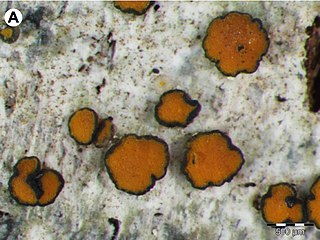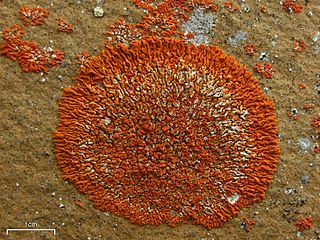Ioplaca is a genus of crustose lichens in the family Teloschistaceae. The genus was circumscribed in 1977 by Czech lichenologist Josef Poelt with Ioplaca sphalera assigned as the type species.
Jan Eric Ingvar Kärnefelt is a Swedish lichenologist.

Gyalolechia is a genus of lichen-forming fungi belonging to the family Teloschistaceae. It contains 18 species of crustose lichens.

Ikaeria is a genus of two species of crustose lichens in the family Teloschistaceae. Both species grow on twig bark of shrubs and trees. It was circumscribed in 2017 by lichenologists Sergey Kondratyuk, Dalip Kumar Upreti, and Jae-Seoun Hur, with Ikaeria aurantiellina assigned as the type species. This lichen was previously placed in the genus Caloplaca, but molecular phylogenetic analysis showed that it belonged in a lineage that was genetically distinct from that genus. Ikaeria serusiauxii was added to the genus in 2020.

Ikaeria serusiauxii is a species of crustose lichen in the family Teloschistaceae. It is found in the Madeira Archipelago and Canary Islands (Macaronesia), as well as in coastal regions of Algarve and Estremadura in mainland Portugal, where it grows on twigs and branches of trees and shrubs. It was described as a new species in 2020 by lichenologist Harrie Sipman. The type specimen was found on Porto Santo Island, on the lower slopes of Pico do Facho, at an altitude of about 350 m (1,150 ft). Here it was growing on fallen pine trees. The specific epithet honours Belgian lichenologist Emmanuël Sérusiaux, "who contributed significantly to the exploration of the lichen diversity of Macaronesia".

Squamulea is a genus of lichen-forming fungi in the family Teloschistaceae. It has 15 species. The genus was circumscribed in 2013 by Ulf Arup, Ulrik Søchting, and Patrik Frödén, with Squamulea subsoluta assigned as the type species. Five species were included in the original account of the genus. The genus name alludes to the squamulose growth form of most of its species. Squamulea has a worldwide distribution; when the genus was originally created, the centre of distribution was thought to be in southwestern North America.
Sirenophila is a genus of crustose lichens in the subfamily Teloschistoideae of the family Teloschistaceae. It has four species with an Australasian distribution.
Caloplaca kedrovopadensis is a little-known species of crustose lichen in the family Teloschistaceae. It is only found in the Kedrovaya Pad Nature Reserve in the Russian Far East, and on the Jiri Mountain of South Korea. The lichen has been recorded growing on rocks and on bark.
Alfred Mycolayovych Oxner was a Ukrainian botanist and lichenologist. His research covered various areas: floristics, taxonomy, phylogenetics, phytogeography, and phytosociology. Oxner founded the National Lichenological Herbarium of Ukraine.
Neobrownliella is a genus of crustose lichens in the subfamily Teloschistoideae of the family Teloschistaceae. It has five species. The genus was circumscribed in 2015 by lichenologists Sergey Kondratyuk, Jack Elix, Ingvar Kärnefelt, and Arne Thell, with Neobrownliella brownlieae assigned as the type species. It is a segregate of the large genus Caloplaca. Characteristics of Neobrownliella include a thallus that is continuous or areolate, the presence of anthraquinones as lichen products, a cortical layer with a palisade paraplectenchyma, and the lack of a thick palisade cortical layer on the underside of the thalline exciple. Two species were included in the original circumscription of the genus; an additional three species were added in 2020.

Tomnashia is a genus of lichen-forming fungi in the family Teloschistaceae. It has four species of saxicolous (rock-dwelling), crustose lichens that occur in southwestern North America.
Teuvoahtiana is a genus of lichen-forming fungi in the family Teloschistaceae. It contains three species of saxicolous (rock-dwelling), crustose lichens, all of which occur in South America.
Elixjohnia is a genus of lichen-forming fungi in the family Teloschistaceae. It has four species of saxicolous (rock-dwelling), crustose lichens that occur in Australasia.

Rusavskia is a genus of lichen-forming fungi in the family Teloschistaceae. It has 12 species. It is a member of the subfamily Xanthorioideae. The thallus of Rusavskia is characterized by its foliose (leaf-like) structure with distinct and typically narrow lobes that curve outwards.
Rusavskia indica is a species of both corticolous (bark-dwelling) and saxicolous (rock-dwelling) lichen in the family Teloschistaceae. Found in India, it was formally described as a new species in 2017 by lichenologists Sergey Kondratyuk and Dalip Kumar Upreti. The type specimens were collected in Jammu-Kashmir.
Gondwania is a genus of lichen-forming fungi in the subfamily Xanthorioideae of the family Teloschistaceae. It has three species. The genus was circumscribed by lichenologists Ulrik Søchting, Patrik Frödén, and Ulf Arup. The type species is G. cribrosa, a species that was first named Polycauliona cribrosa by Auguste-Marie Hue in 1909. The genus name refers to the ancestral supercontinent Gondwana.
Marchantiana is a genus of lichen-forming fungi in the family Teloschistaceae. It contains seven species of corticolous (bark-dwelling), crustose lichens that occur in the Southern Hemisphere.
Orientophila is a genus of lichen-forming fungi in the family Teloschistaceae. It has 15 species of mostly saxicolous (rock-dwelling), crustose lichens. All Orientophila species occur in Northeast Asia including China, Japan, South Korea, and the Russian Far East.
Xanthaptychia is a genus of lichen-forming fungi in the family Teloschistaceae. The genus, circumscribed in 2017, has three corticolous (bark-dwelling) species.
Upretia is a genus of lichen-forming fungi in the family Teloschistaceae. It has three species of saxicolous (rock-dwelling), crustose lichens. Upretia is characterised by its small ascospores and narrow, rod-shaped conidia. The distribution of the genus ranges from mid-altitude rocky terrains in India to both arid and higher altitudinal environments in China.





